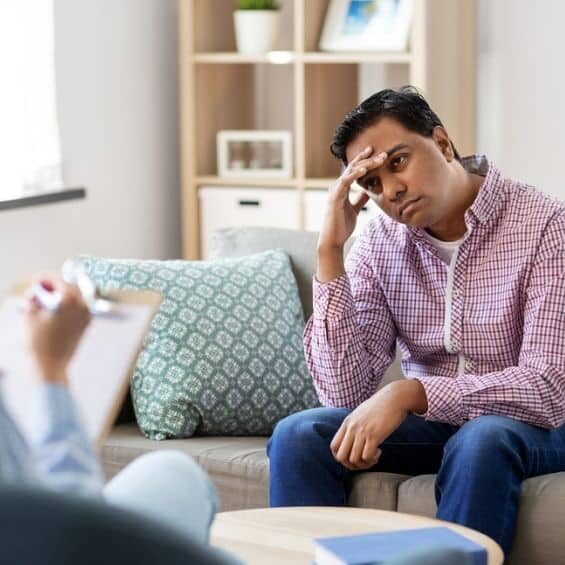
Exposure Therapy
in Houston, TX and Online
What is Exposure Therapy?
Exposure therapy helps people confront their fears rather than avoid them. In fact, avoiding things we’re afraid of actually increases our fear. Being exposed to the very thing you’re most afraid of likely sounds like a nightmare. In fact, you probably take deliberate steps to avoid people, places, objects, or even animals that might remind you of past trauma or trigger severe anxiety. Unfortunately, this behavior actually reinforces fear and anxiety. The phrase “exposure therapy” may sound contradictory. How could exposure to these perceived threats be therapeutic? The answer is habituation. Over time, your brain learns not to “sound the alarm” when you are not in real danger.How Does Exposure Therapy Help You Overcome Your Fears and Phobias?

What does exposure therapy treat?
Exposure therapy is a type of cognitive behavior therapy that treats fear and anxiety, helping people to become less fearful over time. It is a highly effective treatment for obsessive compulsive disorder (OCD), social anxiety, panic disorder, generalized anxiety disorder, PTSD and phobias such as fear of flying.
Don’t worry, your therapist won’t be forcing you into dangerous situations or pushing you way out of your comfort zone. You’ll always be in a safe environment.
Over time, exposure therapy can teach you that the things you fear most aren’t so scary after all.
Read on to learn how exposure therapy for anxiety can help you break through your fears.


Offers a Safe Context
Therapy can help you treat “threats” as no longer dangerous
If you encounter something you view as a threat at a random time and place, you may react with fear or even have a panic attack.
But in exposure therapy, the “threat” is downgraded because you’re in a controlled environment where nothing can physically hurt you.
You have a chance to face your fears, but the stakes are low. You’ll have an opportunity to come face to face with the threat, but you’ll learn not to associate it with dangerous situations.
Essentially you teach your brain to unlearn the connection between the feared objects or situation and an anxiety response.


Therapy teaches self sufficiency and improved coping
Exposure therapy gives you the chance to prove to yourself that you can handle whatever you view as threatening. Fear is often rooted in a belief that we’re incapable of dealing with certain people or scenarios, and that we’ll suffer when we fail to act with confidence or bravery.
During an exposure therapy session, you’ll learn that you are more capable than you previously thought. When you have to deal with the same situation in real life, you can draw on the memory of conquering your fear and the tactics you used.
Therapy provides graded exposure – not too much too soon
Let’s say that you have a phobia of spiders. Your therapist is not just going to walk into your first exposure therapy session and hand you a tarantula. Instead, you might begin by only looking at photos of spiders or watching videos.
As you gradually get more and more accustomed to facing your fears, whatever they may be, they will begin to seem less and less scary. This response is because you’ll have time to adjust and learn new strategies for dealing with them.
It’s not like diving right into a pool. It’s more like easing your way into the water until you’re comfortable with the temperature.
Therapy encourages shifting beliefs
Our thoughts aren’t necessarily facts. But we often believe them without hesitation. This mindset means that many of our fears aren’t rooted in reality or honest expectations. Part of exposure therapy is learning when we need to take a step back and call our thoughts and beliefs into question.
This approach doesn’t mean we can’t trust ourselves, but we need to know when we’re giving in to limiting beliefs. Exposure therapy can teach you to form new, realistic thoughts around the source of your phobia or trauma.
You’ll learn relaxation techniques
Before you even begin exposure therapy, your therapist will teach you a few relaxation techniques that you can employ when you start tackling your phobia. That way, you won’t just be floundering if your heart starts to race, and you feel the anxiety coming on.
You’ll have a few methods in your back pocket to help you see the session through.


Exposure and Response Prevention FAQ's
When people have an anxiety disorder such as social anxiety disorder, posttraumatic stress disorder, OCD, specific phobia, or panic disorder, they avoid the object or situation that triggers anxiety such as:
- meeting new people or having a conversation
- giving a presentation
- flying or driving on the freeway
- touching surfaces
- distressing memories, thoughts or feelings
When you avoid the things you are afraid of, you experience relief in the moment.
Unfortunately, in the long-term anxiety gets worse over time the more a person avoids. When you avoid feared objects or situations, your brain is reinforced to have fear. Essentially, avoiding teaches your brain to be more afraid.
Exposure treatment works through gradual exposure
By gradually exposing yourself to the thing you are afraid of, your brain learns not to be afraid.
The way it works is through a process called habituation.
If you've ever watched a scary movie, you are familiar with this. The first time you watch it, you feel terrified. The next few times, you start to notice it's a bit less scary. After watching it several times, you start to notice how fake and unrealistic the props are.
Exposure therapy involves exposing yourself gradually in just the same way. The more you do an exposure, the less scary it gets. This is the first goal of exposure therapy.
Therapy teaches you that you can cope and fear or anxiety is not necessarily accurate.
Secondly, in exposure, you unlearn the connection between what anxiety predicts will happen and what actually happens. Anxiety predicts a worst case scenario will happen if you do something scary. With exposure, you actually test the theory.
For example, let's say you fear having a panic attack while exercising. You can begin by going for a short walk out the door. Then gradually moving up to a short walk down the block. In doing so, you learn 1) you can cope with uncomfortable feelings of anxiety, 2) exercising does not necessarily lead to a panic attack.
When you face your fears you can overcome them.
In therapy sessions, you will begin with your therapist learning more about the thoughts, feelings and situations that make you anxious.
Next, you will learn relaxation techniques such as progressive muscle relaxation that will help when feeling anxious.
You will make a list of things that trigger your anxiety. You'll rank the list from least anxiety provoking to most. These things are referred to as feared stimuli - the objects or situations that trigger your anxious thoughts, feelings or behaviors.
In session, you will start with imaginal exposures or in vivo exposures that trigger a small amount of anxiety. Over time you will slowly work up to things higher on the list. Eventually you will practice exposure to these feared situations outside of the therapy office.
For example, you might begin by having a conversation with your therapist, then saying hello to a familiar person and gradually working your way up to a conversation with another person.
Physical sensations may also be an anxiety trigger, especially in the case of panic. In these situations a type of exposure referred to as interoceptive exposure might be used. This means, you are exposed to a mild level of the physical sensations in the safe environment of the therapist's office.
Therapy for anxiety disorders typically takes 16-20 weeks, meeting once weekly for a successful outcome. This may vary based on client factors and symptom severity.
Exposure and response prevention is a type of exposure therapy for OCD specifically. In ERP, you are exposed to the thing that is triggering your anxiety and then choosing not to engage in compulsive behavior once your anxiety has been triggered.
Over time, this changes your brain's response to triggers and reduces your anxiety.
Prolonged exposure is a type of exposure therapy for PTSD.
Begin Exposure Therapy for Anxiety With an Experienced Therapist
Wondering if therapy could help you work through your anxiety, OCD, worries, phobia or panic disorder? Let’s see if exposure therapy is the right path for you.
Eddins Counseling Group in Houston, TX, has experienced therapists that specialize in anxiety and OCD. Give us a call to learn more about how therapy can help you overcome your anxieties and fears.
Get Help From a Specialist in Exposure Therapy
Ron DonLevy
Your feelings matter and you deserve to be heard. Ron will join you on your journey of personal growth, healing, and change.
BOOK AN APPOINTMENTTiara Runyon
Tiara offers a collaborative approach, fit to suit your individual needs. Her experience includes working with those facing life transitions and…
BOOK AN APPOINTMENTVanessa Guidry
Vanessa works with teens, young adults and families. She helps with behavioral concerns, emotional stress such as anxiety, anger and depression,…
BOOK AN APPOINTMENTWhat Clients Are Saying
Don’t Hesitate To Reach Out
If you are looking for a therapist, don’t hesitate to reach out to Eddins Counseling Group. They care about their clients and provide amazing customer service. Their therapists are highly trained In evidence-based practices such as DBT and EMDR. They also see couples, which can be really hard to find! Reach out to them today. You won’t be disappointed.















